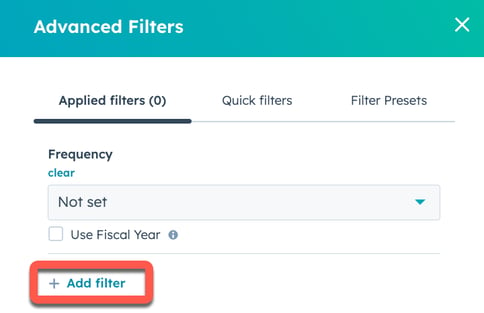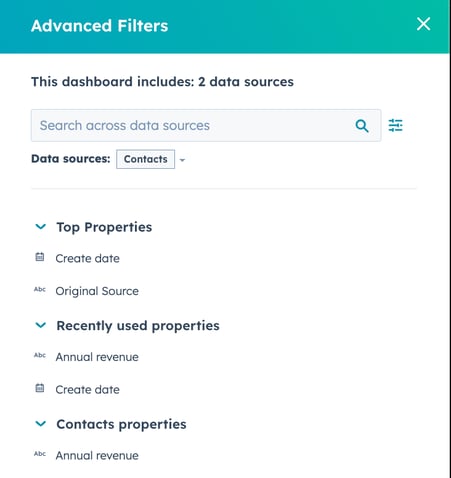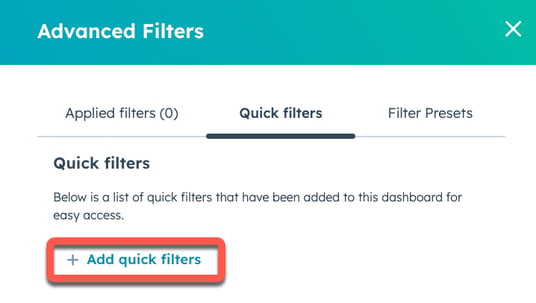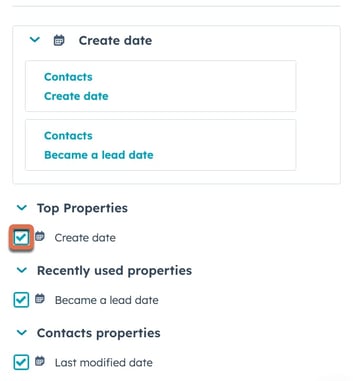- Knowledge Base
- Reporting & Data
- Dashboards
- Use dashboard filters
Use dashboard filters
Last updated: August 15, 2025
Available with any of the following subscriptions, except where noted:
Using properties or custom properties, apply filters across all of your single object and cross object reports in your dashboards. Create quick filters to group multiple properties.
Apply a dashboard level filter
- In your HubSpot account, navigate to Reporting > Dashboards.
- At the top, click filter Advanced filters.
- Click + Add filter.

- Search for and select your property. When searching, view the number of results that contain the keyword and refine your results by deselecting data sources. In the Recently used properties section, you can view the three most recently selected properties used to filter in the dashboard. Learn more about filtering your records.

- Set the criteria for the filter, then click Apply filter. When configuring your filter, view the data source used by the report in the bottom left of each report.

- To apply additional filters, click + Add filter.
Please note:
- When a dashboard filter is applied, the filter will only affect reports that use the data source that the property belongs to. For example, if filtering by the Contact owner property under the Contact data source, only reports using that data source will be affected.
- Funnel reports built with the journey report builder do not support dashboard filters.
- When you've applied your dashboard filters, you can hover over the information icon to view the filters applied to the dashboard and the individual reports. Reports on dashboards will display data based on the dashboard filters AND existing report filters applied.
- Dashboard filters: lists the filters that have been applied to report filters.
- Individual reports: lists the filters applied to the report and any overridden report filters.
- Dataset reports: list the filters applied to the report and any overridden report filters.

Please note: if viewing an individual report from the view & filter action, filters set at the dashboard level will not be applied.
Apply a frequency to a dashboard
To set a frequency for your dashboard:
- In your HubSpot account, navigate to Reporting > Dashboards.
- In the top left, click filter Advanced filters.
- Click the Frequency dropdown menu and select a frequency for your dashboard.

- To use your fiscal year settings, click the Use Fiscal Year check box.
Create and use quick filters on your dashboard
Quick filters can be used to pin properties to the top of the dashboard for easy access and to allow other users to use the same filters.
Please note: not all filters can be used as quick filters, only available will display in the panel.
Create a quick filter
To pin properties to the top of the dashboard:
- In your HubSpot account, navigate to Reporting > Dashboards.
- At the top, click filter Advanced filters.
- Navigate to the Quick filters tab. Then, click + Add quick filters.

- In the right panel, select the checkbox next to the property you want to add as a quick filter to the dashboard.
- Click Add.

- The quick filter will be added to the dashboard and can be configured in the top left. You can add up to five quick filters to a dashboard.
Please note: quick filters are specific to a dashboard, users will need to set up quick filters on a per dashboard basis. Also, only owners and users with edit permissions or above for a dashboard can add, edit, or remove quick filters.
Create a quick filter using multiple properties
You can select multiple properties to group together in one quick filter, and add a custom label and description.
- The properties grouped together must have the same property type. For example, Activity date and Create date within the Deals data source can be grouped together because they are both date properties.
- The operators and values of properties in a quick filter must be the same type to be grouped together. For example, Contact owner and Deal owner can be grouped because the value for the filter can only be Hubspot users.
- To use a property in a quick filter, they must not already be added to the dashboard.
- In your HubSpot account, navigate to Reporting > Dashboards.
- In the top left, click + Quick filters.
- In the box, click Create or Edit.
- Click the checkbox next to the properties you want to add to your quick filter.

- Click Customize.
- Enter a label and a description for your quick filter.
- Then, click Save.
Generate dynamic quick filters
Create dynamic quick filters based on the reports in your dashboard. Dynamic quick filter groups allow you to quickly narrow down the data displayed to only those records that are most important. For example, when generating the Owners dynamic quick filter, it will analyze the reports on your dashboard and will generate a filter that automatically updates and groups owner properties.
The dynamic Date range quick filter will be generated based on any date property set in your reports, and will only affect that property of each report when applied to the dashboard.
- If a dynamic quick filter is edited, dynamic functionality will be removed. It will instead become an advanced filter that will need to be manually updated.
- To generate a dynamic quick filter using multiple properties, there must be at least one single object report on the dashboard.
- In your HubSpot account, navigate to Reporting > Dashboards.
- In the top left, click + Quick filters.
- Click the checkbox next to the dynamic quick filter you want to add to your dashboard. Then, click Add.

Manage and share your dashboard filters
- To edit applied dashboard filters:
- In your HubSpot account, navigate to Reporting > Dashboards.
- At the top, click filter Advanced filters.
-
- Click an existing filter and edit its criteria.
- Click Update filter.

- To delete a dashboard filter:
- In your HubSpot account, navigate to Reporting > Dashboards.
- At the top, click filter Advanced filters.
-
- Hover over an existing filter and click the delete delete icon.

To remove a quick filter from a dashboard:
- At the top, click filter Advanced filters.
- Navigate to the Quick filters tab.
- Click the delete delete icon to remove the quick filter.
To email a dashboard with filters applied:
- Apply your filters.
- In the top right, click the Share dropdown menu. Then select Email this dashboard.
- In the Dashboard context section, select Send with current dashboard filters. The email will be sent with the filters that are applied to the dashboard at that time.

- Click Send now.
To share a dashboard with filters applied:
- Apply your filters.
- Copy the dashboard URL from your browser. Please note the URL updates automatically to reflect the filters you have added and applied.
Please note:
- Any additional filters applied to the dashboard will only apply for the user that applied them, they don't affect the dashboard for other users.
- Dashboard filters will be saved in your current browser session. i.e., if you revisit the same dashboard again, in the same browsing session, the dashboard filters you most recently selected will still be applied.
How do dashboard level filters interact with reports?
Dashboard filters only apply to reports that use the same data source that was applied when the filter was created. When you apply a dashboard level filter, that filter will get added to any existing report level filters for reports that have the same data source of the dashboard level filter using AND logic.
If a report level filter matches a dashboard level filter, then the dashboard level filter takes precedence and overrides the report level filter. For example, if a report has a report level filter of Contacts: Create date is Yesterday, but the dashboard level filter is Contacts: Create date is Tomorrow, then the dashboard level filter will override the report level filter.
However, for custom reports with more complex filters (i.e. reports with AND/OR statements and different groupings of filters), if a dashboard level filter overlaps with the report level filter, it does not override the report level filter and instead simply gets added onto the report level filter using AND logic.
Please note: when a List Membership filter is applied to a dashboard with single object reports that also contain a List Membership filter, the filters will work with an AND logic.
Dynamic Date range filter
When a user applies the dynamic Date range quick filter, for single object reports not built in the custom report builder:
- If the report has an explicit date property set that matches one of the properties that consist of the dynamic Date range quick filter, then the dynamic Date range quick filter is applied to the report, and will override the value of the report’s explicit date range property.
- Otherwise, it won't apply the dynamic Date range quick filter to the report.
When a user applies the dynamic Date range quick filter to reports with multiple objects as data sources. The dynamic Date range filter follows the same rules as any other dashboard level filter that gets applied. If the reports share the same data sources as any of the properties that consist of the dynamic Date range filter. Then those properties are applied to the report.
For example, a dynamic Date range quick filter has two date properties:
- Deals: Close date
- Deals: Create date
A dashboard has three reports:
- Reports A and B are single object reports not built from the custom report builder w/ Deals as a data source
- Report A has Deals: Close date as its explicit date property.
- Report B has Deals: Open date as its explicit date property.
- Report C is built from the custom report builder with Deals as the data source also.
When the dynamic Date range quick filter is applied to the dashboard, the following occurs:
- Report A has its Deals: Close date date property overridden by the dynamic Date range quick filter.
- Report B is unaffected as it doesn't share the same property as any of the properties in the dynamic Date range quick filter.
- Report C has both Deals: Close date and Deals: Create date applied.
Frequency
You can also set the frequency field for reports on a dashboard level.
To set the frequency field for the dashboard:
- Click Advanced filters.
- Select a frequency option.
- The affected reports will update automatically.
Changing the dashboard level frequency will update the frequency setting applied to all your single object reports. For reports built in the custom report builder, the frequency setting of your reports date field will be updated if there is only one date field used in your report that has a frequency set.
- For pipeline and funnel-based reports, the date property for these reports can't be changed on the dashboard filter level. To change the date range filter for these reports, click the View and filter icon on the report.
- Some filters won't apply to reports even if the data source of the filter and report are the same. These are properties that only affect single object reports that weren't built in the custom report builder.